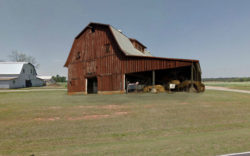After two years of controversy, Selig Enterprises has pulled out, leaving probably a majority of Athens to breathe a sigh of relief over this project’s demise. While most of us agree that the former Armstrong & Dobbs property is a prime piece of real estate and should be developed, it just needs to be developed in a little more Athens-friendly way. The development, which clearly belonged in metro Atlanta, would have demolished all the historic structures on the property and replaced them with generic-looking student housing and parking decks.
While many of the Armstrong & Dobbs warehouses and surrounding buildings are in poor shape, if not ruins, not all of them are. Creating the most controversy was the proposed demolition of the building that formerly housed Jittery Joe’s Roasting Co.
In an effort to save the historic structure, Jack Crowley’s downtown master plan proposed moving the building across the street and incorporating it into a park in front of the Multimodal Center. Moving the building may no longer be necessary. Though the roaster has gone to the Quonset huts on Barber Street, there’s now a possibility that something else could take its place in the former beer warehouse built in the 1920s. Like the roaster, many of the buildings Selig planned to demolish were contributing structures within the Athens Warehouse Historic District on the National Register of Historic Places, the only totally non-residential historic district in Athens. It’s largely comprised of late 19th and early 20th Century brick structures that originally served as warehouses, commercial structures and depots. Though the district is not architecturally unique, it serves as a great—and large—example of turn-of-the-century development patterns in small Southern towns. Perhaps more importantly, the district serves as a time capsule for Athens’ industrial heritage. It denotes a time when Athens was a center of industry in the South and railroads, not four-lane highways, were the means to transport goods.
A large portion of the Warehouse Historic District was to be torn down to make way for the Selig development. While the Jittery Joe’s building garnered the most attention, two other contributing structures to the district were slated for demolition—a warehouse constructed in 1918 and a former cotton shed built between 1903–1908 and used as storage for the F.M. Coker Cotton Warehouse (Flagpole‘s office building, for now). Several other buildings on the Armstrong & Dobbs property were slated for demolition, though they are non-contributing structures, and some are just outside of the historic district. Other buildings located within the Warehouse Historic District that were not a part of Selig’s plans include: the F.M. Coker Cotton Warehouse, the Farmer’s Hardware Building (aka. Farmer’s Exchange Lofts), the Hodgson Oil Refinery, the Foundry Street Warehouses and the Foundry Park Inn & Spa.
These old commercial buildings on the Armstrong & Dobb property may very well be torn down for future development, especially considering that some of them are non-contributing structures in disrepair. Even if the future holds new development in this part of town, like the R.E.M. steeple, these historic structures should be adaptively reused and preserved, not demolished. Keeping every old building in town is not feasible, efficient or desirable, but those buildings that have been deemed important, such as those that contribute to a historic district, should be preserved and reused.
Like what you just read? Support Flagpole by making a donation today. Every dollar you give helps fund our ongoing mission to provide Athens with quality, independent journalism.









